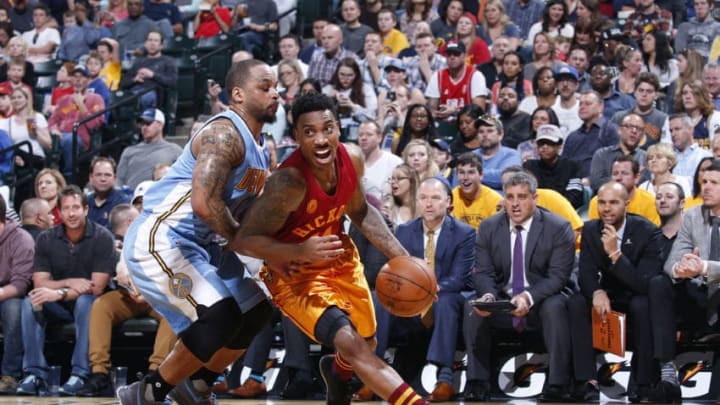How Jeff Teague can make Karl-Anthony Towns even better

The Timberwolves raised some eyebrows this offseason when they signed Jeff Teague to a three-year deal worth $57 million. While it’s a decent contract for a one-time All-Star in the prime of his career, Teague is at his best with the ball in his hands and will therefore take important touches away from Karl-Anthony Towns, Jimmy Butler and Andrew Wiggins, all of whom can create their own shot in volume.
It would help if Teague was a knockdown shooter who could space the floor for Towns, Butler and Wiggins, but he’s not at the same level as some of the other point guards who were available such as Kyle Lowry, George Hill and Patty Mills. He isn’t the same type of passer as Ricky Rubio, either, whom the Timberwolves traded to the Jazz this offseason to pave the way for the Teague signing.
Where Teague is an upgrade over Rubio and some of the other free agents available this offseason is in the pick-and-roll. The Timberwolves were the second-most efficient team on rolls last season with an average of 1.14 points per roll possession, much of which was due to the versatility of Towns. (Only Anthony Davis scored more points per game than Towns as the roll man and Towns averaged 1.23 points per possession). They struggled, however, to convert shots as the ball handler in the pick-and-roll, ranking in the 27.6 percentile with 0.81 points per possession.
Read More: What Fultz and Simmons can learn from LeBron and Kyrie
Unlike Rubio, Teague checked out as one of the best pick-and-roll scorers last season. It made up 41.2 percent of his offense and he ranked in the 86.4 percentile with 0.98 points per possession. The only starting point guards who converted those opportunities at a higher rate were Kyle Lowry, Isaiah Thomas, Damian Lillard, James Harden, Mike Conley, George Hill and Eric Bledsoe. Trailing slightly behind Teague in pick-and-roll scoring efficiency were Kemba Walker, Chris Paul and Stephen Curry.
Teague excels in pick-and-rolls because he has developed into a capable three-level scorer. He’s not the best outside shooter in the NBA, but he made 45.1 percent of his mid-range pull-ups and 34.4 percent of his perimeter pull-ups last season. That means he can take advantage of defenses going underneath screens in ways Rubio, who made 45.2 percent of his mid-range pull-ups on almost 100 less attempts and 19.2 percent of his perimeter pull-ups, couldn’t consistently with the Timberwolves.
Teague also got to the basket in volume last season, although he struggled with his efficiency when he got there, shooting only 44.5 percent on drives.
Teague’s ability to score efficiently out of the pick-and-roll should only make Towns a greater threat as the roll man. Teague has played with a number of pick-and-pop big men throughout his career — Al Horford and Paul Millsap in Atlanta and Myles Turner in Indiana — so he knows how to manipulate the defense to get them open looks. Of the 444 shots Turner made last season, for example, Teague assisted on 188 of them. In his final season with the Hawks, Teague assisted on 18.2 percent of Millsap’s baskets and 31.9 percent of Horford’s.
As long as Teague can continue to establish himself as a scorer in those situations, these are the sorts of simple passes Towns should expect to receive from him:
The difference is Towns will likely pop to the perimeter as opposed to the mid-range. Turner averaged 3.7 catch-and-shoot attempts per game from mid-range last season and 1.3 catch-and-shoot attempts per game from the perimeter. Towns was basically the opposite with 1.6 catch-and-shoot attempts per game from mid-range and 3.0 catch-and-shoot attempts per game from the perimeter.
Towns was fantastic in both of those areas, making 50.0 percent of his attempts from mid-range and 39.1 percent from the perimeter. In fact, Pau Gasol, Marc Gasol, Jason Smith and Mike Muscala were the only centers to convert 3-pointers at a higher rate than Towns on at least 1.0 catch-and-shoot attempts per game.
It is going to take some time for the Timberwolves to figure out how everyone can get their touches, but Butler and Teague both bring a new element the team was missing last season. For Butler, it’s the ability to manufacture his own shot in almost any situation, which should help them significantly in crunch time. For Teague, it’s the ability to score efficiently out of the pick-and-roll and set up rollers for easy shots.
Assuming Teague and Towns can develop chemistry in the pick-and-roll, it could make up for the lack of shooting the Timberwolves are expected to have. Wiggins and Butler are good enough in that department to prevent their defenders from playing way off of them and Towns is one of the best shooting big men in the NBA. With Gorgui Dieng and Taj Gibson lurking on the baseline for cuts, it should give Teague the space he needs to continue being a dominant pick-and-roll scorer.
It helps that Teague can get his shot off against tight coverage having made 227 of his 524 shot attempts (43.3 percent) within four feet of a defender last season.
Next: Butler is who the Timberwolves need to reach their potential
The best way to think about it is the Timberwolves have gone from running pick-and-rolls with Rubio and Wiggins as ball handlers — both of whom were average in those situations last season — to Teague and Butler — both of whom were elite. Because a lot of their future success hinges on the type of player Towns becomes, pairing him with two players who are legitimate scoring threats in those situations should help him become an even greater scorer in his second most used play type.
Unless otherwise noted, all stats are from NBA.com and its player pages.